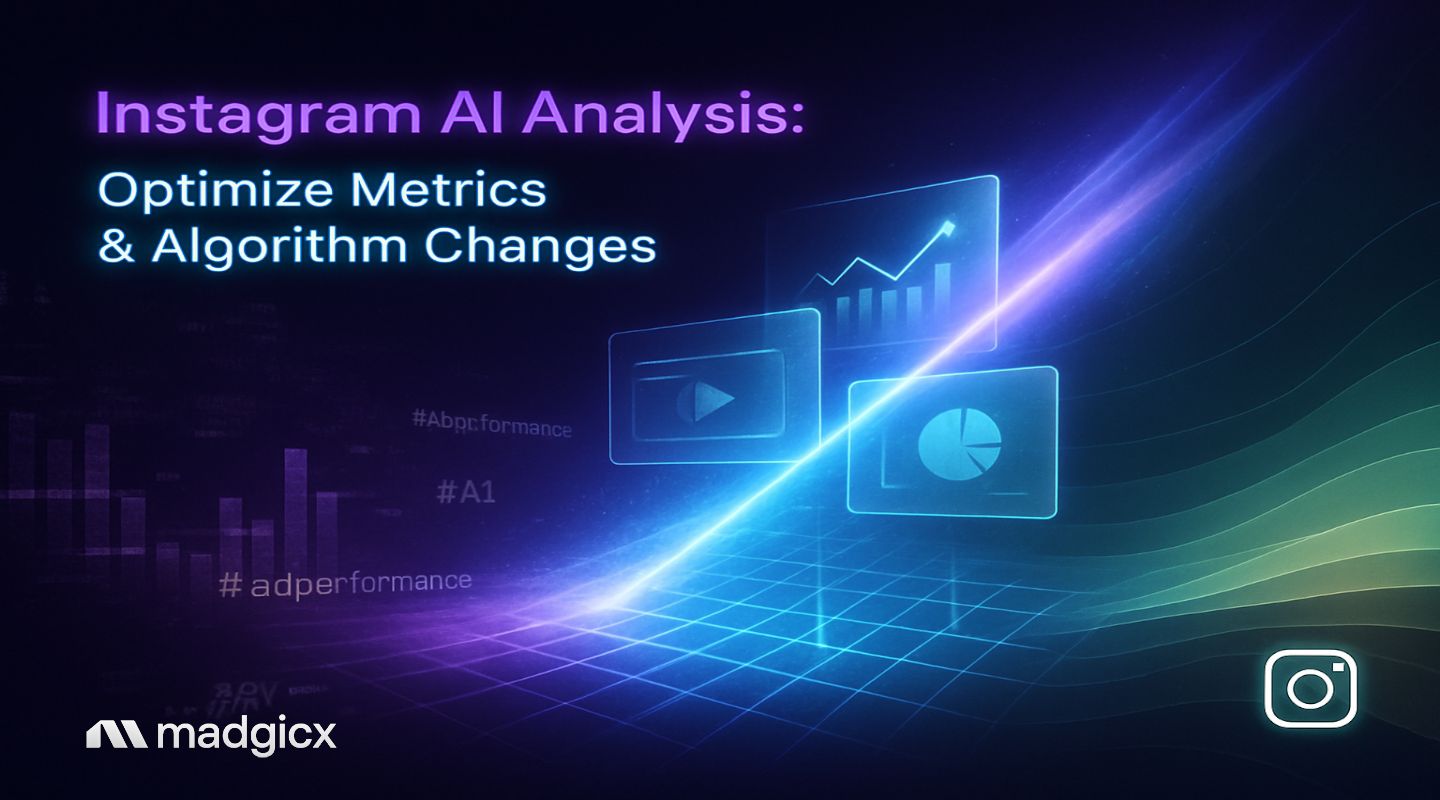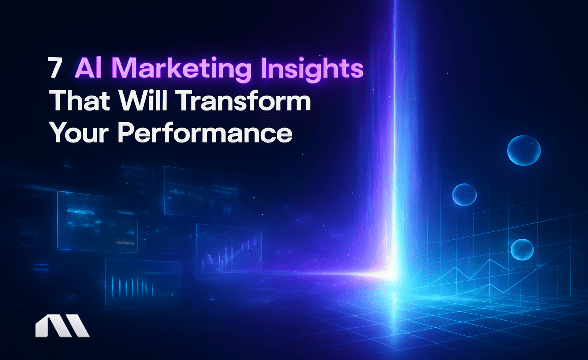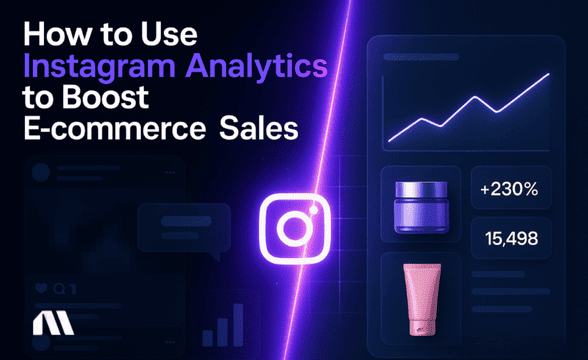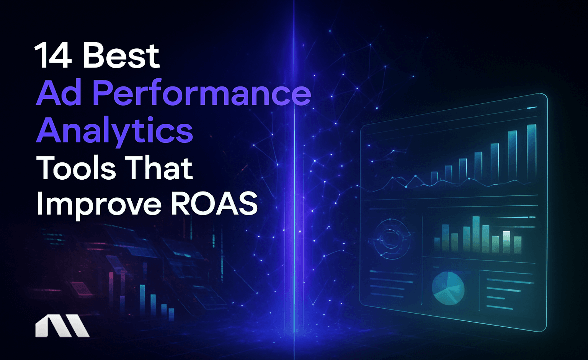Master Instagram AI analysis with algorithm insights, retention metrics, and optimization workflows. Boost shares, reduce skip rates, and maximize performance.
Remember when Instagram success meant hitting that magical 10% engagement rate? Those days are officially over.
Instagram's 2025 algorithm overhaul didn't just move the goalposts—it completely redesigned the game. If you're still chasing likes and obsessing over reach, you're playing by yesterday's rules while your competitors master tomorrow's metrics.
Here's what's really happening: Instagram's algorithm increasingly weighs retention curves alongside traditional engagement signals, prioritizes shares over likes, and considers skip rates alongside simple view counts. The brands crushing it in 2025 aren't just creating better content—they're optimizing for signals most marketers don't even know exist yet.
According to Hootsuite's latest research, Instagram's 2025 algorithm is a series of AI ranking systems where shares are now a top ranking signal.
This isn't another surface-level "algorithm update" post. We're diving deep into the metrics that actually matter, the tools that can track them, and the step-by-step workflows that turn Instagram's new data into real business growth.
What You'll Master in This Guide
By the time you finish reading, you'll understand exactly how Instagram's 2025 algorithm changes affect your content strategy and which metrics actually drive growth now.
We'll walk through step-by-step workflows to use new Insights features like retention curves, skip rates, and follower drivers for content optimization. You'll get tool recommendations and benchmarks to measure your performance against 2025 industry standards.
Plus, a bonus section on SEO optimization strategies for Instagram's new Google/Bing indexing feature.
Instagram's 2025 Algorithm Revolution: What Actually Changed
Let's cut through the noise and focus on what matters. Instagram's 2025 update introduced AI ranking systems that fundamentally changed how content gets discovered and distributed.
The biggest shift? Shares now outrank likes as a discovery signal. This isn't just a minor tweak—it's a complete philosophy change from passive engagement to active content sharing.
The New Ranking Hierarchy
Instagram AI analysis reveals that the platform now evaluates content through multiple ranking systems, each optimized for different content types and user behaviors.
- For Reels: The algorithm prioritizes creativity signals and retention metrics.
- For feed posts: It's all about meaningful interactions and share potential.
- For Stories: Rankings based on close friend interactions and DM responses.
The platform also introduced "Trial Reels"—a testing mechanism where Instagram shows your content to a small audience first, then expands distribution based on early performance signals. This means your first few minutes of posting are more critical than ever.
Pro Tip: Use Trial Reels strategically by creating multiple hook variations for your best content. Post them 2-3 hours apart and monitor first-hour performance to identify winners before broader distribution.
Teen Safety Impact on Reach
Instagram's enhanced teen safety measures aren't just about protecting younger users—they're affecting everyone's reach.
The algorithm now applies stricter content filters and reduces distribution for anything that might be considered "sensitive" content, even for adult audiences. This includes certain product categories, lifestyle content, and even some business-focused posts.
Professional Account SEO Revolution
Here's something most marketers missed: starting July 10, 2025, Instagram began allowing Google and Bing to index public posts from professional accounts.
This means your Instagram content can now appear in search results, opening up entirely new discovery channels beyond the platform itself.
New Instagram Insights Metrics That Matter in 2025
Instagram completely overhauled its Insights dashboard, and if you're still looking for "Accounts Reached," you won't find it.
The platform replaced this with a "Views" baseline that combines what used to be separate reach and impression metrics. This change isn't just cosmetic—it reflects how Instagram's AI actually processes and distributes content.
Understanding the Views Baseline
The new Views metric is Instagram's attempt to create a universal measurement across all content types.
- For Reels: A view counts after 3 seconds of watch time
- For feed posts: Any meaningful interaction or 3+ seconds of viewing time
- For Stories: Simply opening the story
Pro Tip: Export your historical data now if you haven't already. Instagram only retains detailed metrics for 90 days, and you'll need this data to create conversion factors between old and new metrics.
Retention Curves: Your New Best Friend
This is where Instagram AI analysis gets interesting. Instagram's retention metric shows what percentage of viewers continue watching over time, while 'View Rate' is being replaced with 'Skip Rate' for more granular analysis.
Retention curves give you second-by-second data on when people stop watching your Reels.
Here's how to read them:
- Steep drop in first 3 seconds: Hook problems
- Gradual decline throughout: Pacing issues
- Sharp drops at specific moments: Often correlate with scene changes, text overlays, or audio shifts
Post-Level Demographics and Follower Drivers
Instagram now shows you exactly which posts are driving new followers and what demographics they're attracting. This data is gold for content strategy—you can see which topics, formats, or styles are actually growing your audience versus just entertaining your existing followers.
The follower driver insights break down by age, gender, location, and even interests. Use this to identify content themes that attract your ideal customer profile, not just any followers.
Engagement Timing and Carousel Performance
The new Insights show engagement patterns throughout the day and week, but more importantly, they reveal which frames of your carousel posts perform best.
This frame-level data helps optimize product showcases and educational content for maximum engagement.
For our comprehensive approach to Meta advertising analytics, these timing insights become crucial for cross-platform optimization strategies.
Retention & Skip Rate Optimization Workflows
Now let's get practical. Your retention curve is telling a story—you just need to know how to read it.
Most content creators see the data but don't know how to act on it. Here's your step-by-step optimization workflow.
Reading Retention Curves Like a Pro
Start by identifying your average retention rate across all Reels from the past 30 days. This becomes your baseline.
Then, look for patterns:
- 0-3 seconds (Hook Zone): If you're losing more than 60% of viewers here, your opening needs work. Test different opening lines, visual hooks, or immediate value propositions.
- 3-10 seconds (Setup Phase): Gradual decline is normal, but sharp drops indicate pacing problems or unclear value propositions.
- 10+ seconds (Payoff Zone): If retention stays strong here, your content delivers on its promise. If it drops, you might be dragging out the conclusion.
Skip Rate Analysis: The First 3 Seconds Rule
Skip rate is your new obsession metric. Instagram's AI heavily weights this signal because it indicates immediate content quality.
A skip rate above 70% in the first 3 seconds essentially kills your distribution potential.
Quick optimization checklist:
- Start with movement or visual interest
- Lead with the payoff, not the setup
- Use pattern interrupts (unexpected visuals or sounds)
- Test different opening lines for the same content
Hook Testing with Trial Reels
Remember those Trial Reels we mentioned? Use them strategically. Create multiple versions of the same content with different hooks, then let Instagram's AI tell you which performs better in the trial phase.
Testing framework:
- Create 3-5 hook variations for your best content
- Post them 2-3 hours apart
- Monitor first-hour performance metrics
- Double down on the winner with paid promotion
For more advanced testing strategies, our Meta advertising audit guide covers similar optimization principles for paid content.
Maximizing Shares and Discovery Signals
Here's the uncomfortable truth: your content might be entertaining, but is it shareable?
Instagram's 2025 algorithm doesn't care if people like your post—it cares if they share it. This shift requires a fundamental change in content strategy.
Why Shares Outrank Likes
Instagram AI analysis shows that the platform interprets shares as the strongest signal of content value. When someone shares your post to their Story, sends it via DM, or saves it for later, they're essentially telling the algorithm "this content is worth spreading."
This signal carries more weight than 10 likes from passive scrollers.
Content Formats That Drive Shareability
Educational carousels consistently generate the highest share rates. Break down complex topics into digestible slides with actionable takeaways. People share content that makes them look smart or helpful to their network.
Behind-the-scenes content performs well because it's inherently shareable—people love giving others exclusive access to insider information.
Controversial takes (when done thoughtfully) spark conversations and shares, but be careful not to alienate your target audience.
Creating DM-Worthy Assets
Think about what makes you send a post to a friend. Usually, it's content that's either highly relatable, immediately useful, or emotionally resonant.
Design your content with specific sharing scenarios in mind:
- "My friend who's starting a business needs to see this"
- "This perfectly explains what I've been trying to say"
- "This is exactly what we were talking about yesterday"
Measuring Shares Per 1,000 Views
Track shares as a percentage of total views, not just absolute numbers. A post with 1,000 views and 50 shares (5% share rate) is performing better than a post with 10,000 views and 200 shares (2% share rate).
This metric becomes your north star for content optimization.
Pro Tip: Aim for 20+ shares per 1,000 views as your benchmark. Content hitting this threshold typically sees expanded distribution from Instagram's AI.
Instagram AI Analysis Tools by Business Type
Not all analytics tools are created equal, and the 2025 updates have made some more valuable than others.
Here's your tool selection guide based on your specific business needs and budget.
For E-commerce Businesses
Iconosquare excels at competitor analysis and product performance tracking. Their new 2025 features include retention curve comparisons and share rate benchmarking across your industry.
The tool integrates with Shopify to show which Instagram content drives actual sales, not just engagement.
Social Status offers the best hashtag performance tracking for the new algorithm. Since hashtag effectiveness has shifted dramatically in 2025, their real-time hashtag analytics help you adapt quickly to algorithm changes.
For Agencies Managing Multiple Accounts
Sprout Social provides the cleanest client reporting for the new metrics. Their retention curve visualizations and skip rate analysis make client presentations much easier.
The tool also offers team collaboration features for content approval workflows.
Hootsuite remains strong for team management and scheduling, but their analytics have improved significantly for 2025. The cross-platform insights help agencies show how Instagram performance affects overall social media ROI.
For Performance Marketers
Socialinsider offers the most comprehensive benchmarking data for 2025 metrics. You can compare your retention rates, share rates, and skip rates against industry averages and direct competitors.
Metricool provides excellent cross-platform analytics, showing how Instagram performance correlates with other advertising channels. This is crucial for cross-platform optimization strategies that many performance marketers are implementing.
Tool Integration with Madgicx
While these tools excel at analytics, they lack creative optimization capabilities. Madgicx bridges this gap by combining Instagram performance data with AI-powered creative generation for Meta advertising campaigns.
You can see which content themes perform best, then automatically generate variations optimized for those themes.
The integration also helps with multi-touch attribution analysis, showing how Instagram content influences conversions across your entire Meta advertising funnel.
2025 Instagram Benchmarks and Posting Strategy
Let's talk numbers. Instagram's average engagement rate fell to 0.45% in H1 2025, representing a 24–28% year-over-year decrease, though Reels continue to drive more comments across all page sizes.
This decline isn't necessarily bad news—it reflects the platform's maturation and the shift toward quality over quantity metrics.
Industry-Specific Engagement Benchmarks
E-commerce: 0.35-0.55% average engagement rate, but focus on save rates (2-4% of total engagement) and share rates (1-3% of total views).
- B2B Services: 0.25-0.45% engagement rate, with higher emphasis on carousel performance and educational content shares.
- Lifestyle/Fashion: 0.40-0.70% engagement rate, with strong performance in Stories and Reels retention metrics.
- Food & Beverage: 0.50-0.80% engagement rate, consistently highest share rates across industries.
Reels vs. Other Content Formats
Reels still dominate reach potential, but the gap is narrowing. In 2025, a well-optimized carousel post can achieve 60-80% of a Reel's reach, especially when it generates high share rates.
Stories remain crucial for audience retention and direct response campaigns.
The key insight: format matters less than optimization for the specific metrics Instagram's AI prioritizes for each format type.
Optimal Posting Times Using Account-Specific Data
Generic "best posting times" are dead. Instagram's account-level 'Most active times' feature provides day-by-day peaks based on your specific audience behavior, derived from analysis of over 2 million posts.
Use this data instead of industry averages.
Pro workflow: Check your Insights weekly and adjust your posting schedule monthly. Audience behavior shifts seasonally, and what worked in Q1 might not work in Q3.
Setting Realistic Benchmark Targets
- For accounts under 10K followers: Focus on retention rates above 40% and skip rates below 60%.
- For accounts 10K-100K: Target retention rates above 35% and share rates above 2% of total views.
- For accounts over 100K: Benchmark against direct competitors using tools like Socialinsider, as your metrics will vary significantly by niche.
Reporting Templates for the Views Era
The transition from reach-based to views-based reporting requires new frameworks and KPI structures.
Your old reports won't make sense anymore, and your clients or stakeholders need education on what these new metrics actually mean.
Reconciling Historical Data
Create a conversion factor between your old reach metrics and new Views data. For most accounts, Views roughly equal 1.2-1.5x your previous "Accounts Reached" metric, but this varies by content type and audience behavior.
Monthly reconciliation workflow:
- Export the last 30 days of data before it disappears
- Calculate your account's specific reach-to-views conversion factor
- Apply this factor to historical data for trend analysis
- Document any seasonal variations in this conversion rate
New KPI Frameworks
Primary KPIs for 2025:
- Retention rate (target: 35%+ for Reels)
- Share rate per 1,000 views (target: 20+ shares per 1K views)
- Skip rate (target: <60% in first 3 seconds)
- Follower driver efficiency (new followers per 1,000 views)
Secondary KPIs:
- Engagement timing distribution
- Carousel frame performance variance
- Story completion rates
- DM response rates from content
Client Reporting Templates
For agencies, explaining these new metrics requires visual storytelling. Create before/after comparisons showing how optimization for retention and shares improved overall account performance.
Use retention curve screenshots to show specific improvement areas.
Monthly report structure:
- Executive summary with new KPI performance
- Retention analysis with specific optimization recommendations
- Share rate trends and content theme performance
- Competitive benchmarking using new metrics
- Next month's optimization priorities
For more sophisticated reporting approaches, explore our guide on custom metrics for Meta advertising, which applies similar principles to paid advertising performance.
Frequently Asked Questions
How do I reconcile my old reach metrics with the new Views baseline?
Instagram's Views metric combines what used to be "Accounts Reached" and "Impressions." Export your historical data before the transition and create a conversion factor based on your account's typical reach-to-impression ratio.
Most accounts see Views equal to 1.2-1.5x their previous reach numbers, but calculate your specific factor for accuracy.
What's the difference between retention rate and skip rate?
Retention rate shows the percentage of viewers who continue watching over time throughout your entire video. Skip rate specifically measures the percentage who skip within the first 3 seconds—this is crucial for Reels optimization because it heavily influences Instagram's AI distribution decisions.
Should I focus on shares or likes for better algorithm performance?
Shares are now a stronger ranking signal than likes. Focus on creating content that encourages saves and shares through valuable, actionable, or entertaining content that people want to reference later or send to friends. Aim for 20+ shares per 1,000 views as a benchmark.
How often should I check my Instagram Insights?
Check weekly for optimization decisions, but export data monthly since Instagram only retains 90 days of detailed metrics. This prevents data loss for long-term analysis and helps you maintain historical performance trends.
Do the new algorithm changes affect paid promotion?
Yes, content that performs well organically (high retention, shares) typically sees better paid performance and lower costs. Use organic insights to inform your paid creative strategy—if a post has strong retention curves organically, it's likely to perform well with paid promotion.
What's the best way to improve my retention rate?
Focus on your first 3 seconds with strong visual hooks, lead with value rather than setup, and use pattern interrupts to maintain attention. Test different opening approaches for the same content and let the data guide your optimization decisions.
Optimize Instagram Performance Using AI-Driven Insights
The 2025 Instagram landscape rewards creators and businesses who understand AI-driven metrics and optimize accordingly. Success isn't about creating more content—it's about creating the right content for Instagram's new ranking systems.
Focus on these four critical areas: maximize retention in your first 3 seconds, create genuinely shareable content that adds value to people's networks, leverage post-level demographics for precise audience targeting, and maintain consistent data export workflows to preserve your performance history.
Start by auditing your current content using the new retention metrics we covered. Identify your top-performing posts by share rate, not just likes or comments. Then implement the optimization workflows systematically—test different hooks, analyze retention curves, and adjust your content strategy based on what the data reveals.
The accounts winning in 2025 aren't just creating great content—they're using Instagram AI analysis to create the right content at the right time for the right audience. Master these new metrics, and you'll be better positioned than businesses still focusing primarily on vanity metrics.
Ready to streamline your Instagram optimization while maintaining strategic control? Madgicx combines AI-powered creative generation with advanced analytics integration, helping you master these new metrics while scaling your content production efficiently for Meta advertising campaigns.
Stop guessing what content works. Madgicx's AI Ad Generator creates Instagram content optimized for the new algorithm signals—higher retention, more shares, better discovery. Plus, our analytics integrate seamlessly with Instagram's new metrics to show you exactly what's driving results in your Meta advertising campaigns.
Digital copywriter with a passion for sculpting words that resonate in a digital age.







.avif)







